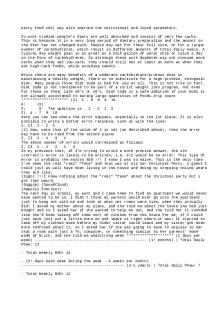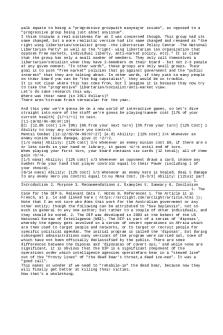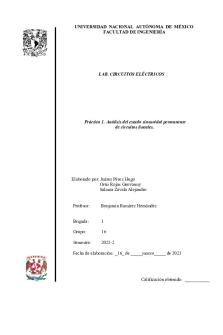Sinusoidal Waveforms - Waveform analysis PDF

| Title | Sinusoidal Waveforms - Waveform analysis |
|---|---|
| Author | Nouman Shahid |
| Course | Power Engineering |
| Institution | University of Greenwich |
| Pages | 8 |
| File Size | 415.7 KB |
| File Type | |
| Total Downloads | 34 |
| Total Views | 142 |
Summary
Waveform analysis...
Description
Sinusoidal Waveforms
Sinusoidal Waveform Example No1 A sinusoidal waveform is defined as: V = 169.8 sin(377t) volts. Calculate the RMS voltage of the waveform, its frequency and the instantaneous value of the voltage, (V)i after a time of six milliseconds (6ms).
Answer We know from above that the general expression given for a sinusoidal waveform is:
Then comparing this to our given expression for a sinusoidal waveform above of V = 169.8 sin(377t) will give us the peak voltage value of 169.8 volts for the waveform. m
The waveforms RMS voltage is calculated as:
The angular velocity (ω) is given as 377 rad/s. Then 2πƒ = 377. So the frequency of the waveform is calculated as:
The instantaneous voltage V value after a time of 6mS is given as: i
Note that the angular velocity at time t = 6mS is given in radians so we have to convert this into an equivalent angle in degrees and use this value instead to calculate the instantaneous voltage value. The angle in degrees is therefore given as:
We also saw that as an alternating quantity, sine waves have a positive maximum value at time π/2, a negative maximum value at time 3π/2, with zero values occurring along the baseline at 0, π and 2π. However, not all sinusoidal waveforms will pass exactly through the zero axis point at the same time, but may be “shifted” to the right or to the left of 0 by some value when compared to another sine wave. o
For example, comparing a voltage waveform to that of a current waveform. This then produces an angular shift or Phase Difference between the two sinusoidal waveforms. Any sine wave that does not pass through zero at t = 0 has a phase shift. The phase difference or phase shift as it is also called of a Sinusoidal Waveform is the angle Φ (Greek letter Phi), in degrees or radians that the waveform has shifted from a certain reference point along the horizontal zero axis. In other words phase shift is the lateral difference between two or more waveforms along a common axis and sinusoidal waveforms of the same frequency can have a phase difference. The phase difference, Φ of an alternating waveform can vary from between 0 to its maximum time period, T of the waveform during one complete cycle and this can be anywhere along the horizontal axis between, Φ = 0 to 2π (radians) or Φ = 0 to 360 depending upon the angular units used. o
Phase difference can also be expressed as a time shift of τ in seconds representing a fraction of the time period, T for example, +10mS or – 50uS but generally it is more common to express phase difference as an angular measurement. Then the equation for the instantaneous value of a sinusoidal voltage or current waveform we developed in the previous Sinusoidal Waveform will need to be modified to take account of the phase angle of the waveform and this new general expression becomes.
Phase Difference Equation
Where:
Am - is the amplitude of the waveform. ωt - is the angular frequency of the waveform in radian/sec. Φ (phi) - is the phase angle in degrees or radians that the waveform has shifted either left or right from the reference point.
If the positive slope of the sinusoidal waveform passes through the horizontal axis “before” t = 0 then the waveform has shifted to the left so Φ >0, and the phase angle will be positive in nature, +Φ giving a leading phase angle. In other words it appears earlier in time than 0o producing an anticlockwise rotation of the vector. Likewise, if the positive slope of the sinusoidal waveform passes through the horizontal x-axis some time “after” t = 0 then the waveform has shifted to the right so Φ...
Similar Free PDFs
Popular Institutions
- Tinajero National High School - Annex
- Politeknik Caltex Riau
- Yokohama City University
- SGT University
- University of Al-Qadisiyah
- Divine Word College of Vigan
- Techniek College Rotterdam
- Universidade de Santiago
- Universiti Teknologi MARA Cawangan Johor Kampus Pasir Gudang
- Poltekkes Kemenkes Yogyakarta
- Baguio City National High School
- Colegio san marcos
- preparatoria uno
- Centro de Bachillerato Tecnológico Industrial y de Servicios No. 107
- Dalian Maritime University
- Quang Trung Secondary School
- Colegio Tecnológico en Informática
- Corporación Regional de Educación Superior
- Grupo CEDVA
- Dar Al Uloom University
- Centro de Estudios Preuniversitarios de la Universidad Nacional de Ingeniería
- 上智大学
- Aakash International School, Nuna Majara
- San Felipe Neri Catholic School
- Kang Chiao International School - New Taipei City
- Misamis Occidental National High School
- Institución Educativa Escuela Normal Juan Ladrilleros
- Kolehiyo ng Pantukan
- Batanes State College
- Instituto Continental
- Sekolah Menengah Kejuruan Kesehatan Kaltara (Tarakan)
- Colegio de La Inmaculada Concepcion - Cebu















